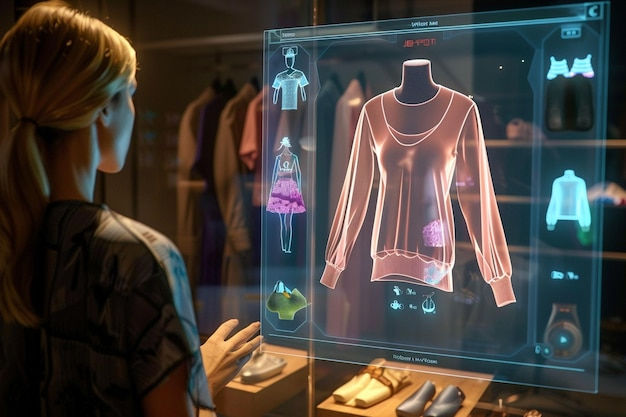How AI Is Transforming the Fashion Industry
- Vaishnavi Parmar
- Jun 6
- 3 min read
Fashion has always been about expression, creativity, and keeping up with change—but lately, the winds of transformation are powered by something unexpected: artificial intelligence. Once a distant tech concept, AI is now weaving itself into every corner of the fashion world, from design studios to dressing rooms, warehouses to your Instagram feed.
What was once purely a human-driven craft is now evolving with data, algorithms, and digital intelligence. This doesn’t mean machines are replacing designers, but rather enhancing what fashion can achieve—faster trends, smarter shopping, and more sustainable choices.
Let’s explore how AI is reshaping the way we wear, buy, and experience fashion.

Smarter Design with Predictive Power
Gone are the days when designers solely relied on intuition or seasonal cycles. Today, AI is helping predict what consumers want before they even know it themselves. By analyzing massive sets of data—from social media trends to past purchase behavior—AI tools can suggest patterns, silhouettes, and even color palettes likely to resonate with future buyers.
Big brands like Tommy Hilfiger and Adidas have already tapped into AI to streamline their design process, using software that reads trend data to spark new ideas. This makes collections not only more in tune with real-time demand but also more efficient to produce.
Personalized Shopping Like Never Before
You might’ve noticed how online stores now feel like they “get” you. That’s AI doing the heavy lifting behind the scenes. Retailers use recommendation engines powered by machine learning to understand what styles you click, what you scroll past, and what you’ve previously bought—then curate suggestions that are increasingly spot-on.
This level of personalization doesn’t just feel nice—it drives engagement and sales. Shoppers no longer waste hours hunting for what they like; AI quietly brings it to them in a few swipes or scrolls. That convenience is changing the very definition of the fashion shopping experience.
Virtual Try-Ons and Digital Fitting Rooms
One of the biggest friction points in fashion is fit. AI is tackling this head-on with virtual try-on tools and sizing assistants. Using augmented reality and 3D body scans, customers can see how clothes might look on their bodies—all from a smartphone or laptop.
From glasses to jeans to dresses, more brands are integrating AI-driven try-on features that reduce the guesswork and improve confidence in purchases. For shoppers, this means fewer returns and a better sense of satisfaction. For brands, it means smarter inventory and fewer wasteful shipments.

Sustainable Solutions for a Greener Industry
Let’s face it: fashion’s environmental impact is no secret. But AI is emerging as a surprising ally in the push for sustainability. Smart inventory systems now forecast demand more accurately, reducing the need to overproduce. AI is also being used in material sourcing, helping identify sustainable fabrics and track the carbon footprint of production processes.
Some startups are even using AI to give new life to unsold inventory, reimagining deadstock into designs that align with current trends. The end result? Less waste, more conscious fashion, and a step toward circular production models.
Revolutionizing Supply Chains and Logistics
Behind every outfit is a long supply chain—and AI is making that chain smarter. From predicting when stock will run low to optimizing warehouse operations, AI improves the flow of goods in ways that save time, money, and energy.
Retailers can now monitor demand in real time and adjust shipments or manufacturing accordingly. This kind of responsiveness is critical in an industry where timing often makes or breaks a season.
Fashion Meets Artificial Creativity
Here’s where things get especially interesting: AI isn’t just crunching numbers—it’s beginning to create. Generative AI tools can now produce designs, graphics, and even entire clothing lines based on learned aesthetics. Some brands have experimented with fully AI-generated collections, where algorithms suggest design elements that humans then refine.
This raises fascinating questions. Is AI becoming a designer? Can creativity be coded? While humans still bring emotional and cultural context, AI adds a new layer of inspiration—one that’s data-rich and boundary-pushing.
What This Means for the Future of Fashion
As AI continues to evolve, its role in fashion will only grow deeper. But this isn’t a story of replacement—it’s one of collaboration. Technology is supporting creatives, streamlining operations, and personalizing experiences in ways we never imagined just a decade ago.
The fashion industry is still very much about artistry and identity. AI doesn’t strip that away. Instead, it sharpens it, allowing designers and shoppers alike to interact with clothing in more meaningful, efficient, and sustainable ways.
If you're curious about where this digital style evolution is heading next, visit https://kahan.in/ —a hub where culture, technology, and creativity intersect in thought-provoking ways.












Comments